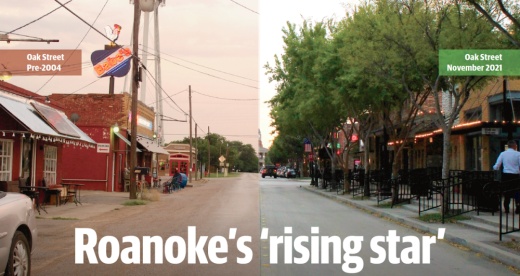The city’s plan invested in infrastructure such as new streets and added standards to attract certain kinds of businesses. It also took steps to preserve the area’s historical character.
The variety of dining options attracted to Roanoke as a result of the redevelopment led the state legislature to name the city “The Unique Dining Capital of Texas” in 2009. The redevelopment also helped Roanoke become an example for other small cities looking to boost their downtown areas.
“We have a lot of cities that come and ask us ... how we did it, what have we done, how we financed it,” Assistant City Manager Cody Petree said. “There’s still a lot more growth coming in ... [and] hopefully more will come [once the Peabody is complete]. ... It’ll be a domino effect.”
‘A two-lane asphalt road’
Curtis Wells co-owns Classic Cafe at Roanoke with his brother, Chris. He recalls how in 1993, there were only a few restaurants in Roanoke, including Babe’s Chicken Dinner House, Dove Creek Cafe and his own. He described the old downtown area as “a two-lane asphalt road.”
“We picked this as an area that was going to grow in the future, and it certainly did,” he said. “[It] took a little longer than we had originally anticipated. But it is certainly there now.”
Roanoke Mayor Scooter Gierisch said the Hwy. 114 bypass and the construction of a Walmart and Home Depot brought concerns among local business owners and city officials on how to encourage visitors to come to Oak Street and enjoy the local amenities. To address these concerns, the Roanoke Downtown Plan was launched in 2004, kickstarting plans to redesign Oak Street.
Gierisch said the city used Grapevine’s success story in redeveloping its historic downtown as inspiration. City council and staff started to work with a consulting group to look at Roanoke’s downtown area.
“When the bypass came around, it’s a very similar situation as to what happened with Grapevine,” he said. “Grapevine redid Main Street, [and] Main Street became a lively and thriving area. So we saw the fruits of their labor and we began to look at the same process. ... Downtown was our only historic area, and we had a few historic buildings that we could work with.”
Project phases
The Roanoke Downtown Plan is divided into four phases, with the last still ongoing. The first phase of the plan focused on establishing the original town as an important economic development asset, and the second focused on implementing zoning codes for Oak Street.
The new zoning placed standards for walkability, streetscape improvements, building typologies and architectural design, according to city documents. The second phase was completed in January 2006.
“[The council wanted] to keep the integrity and improve it, but also keep people coming [while] still trying to keep that small-town feel,” Petree said.
In 2008, the city restored the former saloon into what is now the Roanoke Visitor Center and Museum, marking the start of the third phase. Existing Oak Street infrastructure was renovated, and around $7.6 million was spent on roadway improvements, such as paving, landscaping, streetscape updates, sidewalks and drainage improvements, Petree said. Two roundabouts and additional parking were also added.
The latest phase of the plan—the downtown expansion—led to the extension of Oak Street on the south side and has brought several large developments, city documents show. This included the new $13 million City Hall, a mixed-use city center development from Integrity Group and the Peabody Hotel.
“There’s not another property out in that part of the [metroplex] that’s of the quality that we intend to [have], so we just thought there was a good opportunity for our brand,” said Marty Belz, chair of Peabody Hotels and Resorts, during a June 2021 City Council meeting.
The addition of the Peabody Hotel on the south side of Oak Street is yet another element that matches the downtown aesthetic Roanoke officials are striving for while continuing to be a destination in the metroplex.
“The Peabody is family-owned and operated and I think they saw our vision and we saw theirs...,” Petree said. “You’ll still get that step back in time when you go in there even though it’s modernized... It’s very eclectic.”
As a result, Roanoke has received more than 20 awards since 2008 for its development. Most recently, it won Best New Construction for a city with a population under 50,000 from the Texas Downtown Association for its City Hall completed in 2019.
‘Domino effect’
As Oak Street evolved, more restaurants and businesses came to call downtown home. Wells said the additional restaurants brought new clientele to Classic Cafe at Roanoke. Today, there are 24 restaurants along Oak Street and over 60 restaurants in total across the city, according to the city of Roanoke.
“Having more restaurants in an area just brings more people to the area. So, there’s no competition that I can see from our perspective,” Wells said. “It has certainly brought people to the area and gives us an opportunity to showcase all the different restaurants [in the city]. I’ve gotten some of my best customers from people who didn’t want to stand in line at [other restaurants].”
One of the first restaurants to open on Roanoke’s Oak Street after redevelopment started was Twisted Root Burger Co., based out of Deep Ellum. Gierisch said the restaurant’s Roanoke location ended up outperforming the original Dallas location.
Although Twisted Root’s Roanoke location was unable to weather the COVID-19 pandemic, the burger restaurant brought in more businesses in what Gierisch referred to as a “domino effect.”
“Roanoke was determined many years ago ... to be the central point of the metroplex,” Gierisch said. “[When] SH 170 came and we became a center point of three major highways, the ‘Rising Star of the Metroplex’ was coined and utilized for many years. And then when we became the ‘Unique Dining Capital [of Texas]’, we felt like our star had risen and gotten to the point where we needed to be.”
Integrity Group, a Roanoke-based construction company, is one of several companies that has worked with the city to develop Oak Street.
“The economic impact [from all the upcoming projects] to the town will be—and is—substantial,” Integrity Group owner John Delin said. “And that’s the way the town thinks, and that’s why Roanoke is as successful as it is. [It is] why they’ve attracted people like Peabody to come in down here.”
Among future projects is Integrity Group’s The RO, expected to break ground in the first quarter of 2022 on the west side of City Hall. Boutique apartment complex Magnolia opened Nov. 1 on North Oak Street.
“There’s other cities that are bigger... in DFW—but there’s not too many cities that have the climate that Roanoke has, where [the city] creates good partnerships, and therefore, they attract that kind of stuff,” Delin said.






